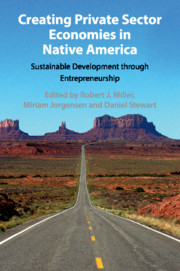 Creating Private Sector Economies in Native America
Creating Private Sector Economies in Native America from Part III - Learning from Business Scholars
Published online by Cambridge University Press: 15 October 2019
The Sustainable Development Goals (SDGs) are a collection of seventeen goals set by the United Nations in 2015. They form the backbone of the organization’s 2030 Agenda for Sustainable Development. The SDGs have been criticized for overlooking Indigenous peoples (IP), principally for 1) inadequate recognition of IPs in the goals and targets themselves, 2) the indicators’ failure to disaggregate IP-specific figures from country-level data, and 3) for failing to recognize the potential contributions of IPs as active participants in attaining the Goals, as opposed to mere recipients. This chapter maps the SDGs to Indian nations in the United States. The chapter highlights examples of renewable energy on tribal lands as a lens through which to examine the ways the United States, tribes, and partners are achieving the SDGs domestically, and to show the necessity of SDG implementation within a framework that protects human rights, particularly the rights expressed in the United Nations Declaration on the Rights of Indigenous Peoples.
To save this book to your Kindle, first ensure no-reply@cambridge.org is added to your Approved Personal Document E-mail List under your Personal Document Settings on the Manage Your Content and Devices page of your Amazon account. Then enter the ‘name’ part of your Kindle email address below. Find out more about saving to your Kindle.
Note you can select to save to either the @free.kindle.com or @kindle.com variations. ‘@free.kindle.com’ emails are free but can only be saved to your device when it is connected to wi-fi. ‘@kindle.com’ emails can be delivered even when you are not connected to wi-fi, but note that service fees apply.
Find out more about the Kindle Personal Document Service.
To save content items to your account, please confirm that you agree to abide by our usage policies. If this is the first time you use this feature, you will be asked to authorise Cambridge Core to connect with your account. Find out more about saving content to Dropbox.
To save content items to your account, please confirm that you agree to abide by our usage policies. If this is the first time you use this feature, you will be asked to authorise Cambridge Core to connect with your account. Find out more about saving content to Google Drive.